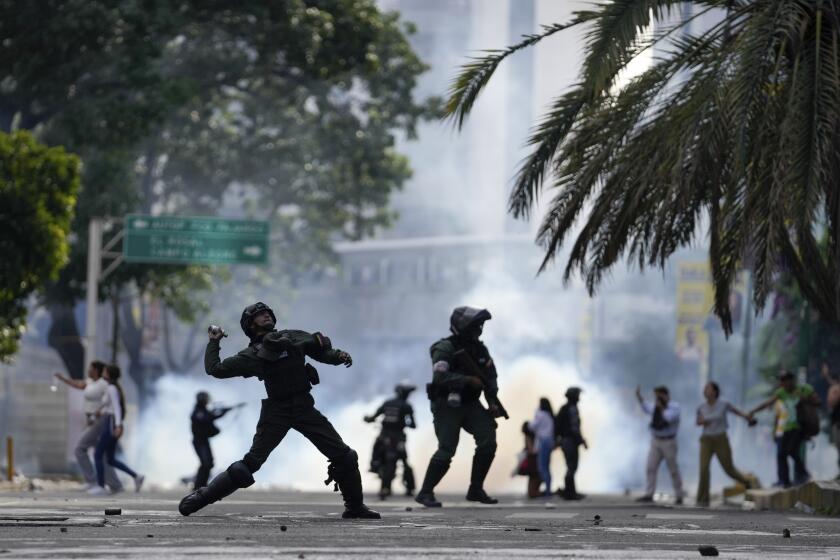The great car-tax swindle
- Share via
The defining issue of the 2003 recall was Gov. Gray Davis’ tripling of the car tax, more officially known as the Vehicle License Fee. The defining issue of Arnold Schwarzenegger’s successful campaign to unseat Davis was his promised rollback of said car tax. Now the defining and perpetual cloud over the Schwarzenegger administration has become the budget’s operating deficit and the amount by which it carries over from one year to the next, or -- as is the case this year -- the amount by which it requires slashing state programs.
And that amount is, of course, just about the same amount as the money lost from cutting -- or, if you prefer, reinstating -- the car tax. How much? $3.8 billion.
But that’s old news. Ask Californians today if they’d rather have the deficit, the slashed budget or the car tax, and it might be neck-and-neck between the first two. The car tax, at the 2% rate that had applied for half a century, is gone forever.
The secret that the number-crunchers in Sacramento know, but that they will never share with the rest of us, is that the tripled car tax is alive and well. We stopped paying it out of one pocket, perhaps, but we’re paying it out of the other.
Explanation is in order, of course. But first, some background.
California used to impose property taxes on cars, but that system was scrapped in 1935 and replaced with the annual registration fee. The amount: 1.75% of the car’s current value. It went up. Quickly. In 1948, it was raised to 2%.
The money was not for the general fund, or for driver services or filling potholes or the Highway Patrol. It was a special fund for the locals. All revenue was distributed to cities and counties to fund operation of local governments.
Then came Proposition 13 in 1978, and the Legislature’s reaction to the cut in property taxes, which also formerly funded the operations of local governments. Sacramento tried to bail out cities, counties and schools with a complicated process of backfilling and fund-switching. In the early 1980s, ostensibly as part of the realignment and bailouts, the Legislature took a huge chunk of the car tax, prompting a voter reaction in the form of a 1986 ballot measure to mandate that, once again, all that money go to the cities and counties.
Keep that move in mind -- money for locals goes to the state and the people take it back for the locals. You’ll notice a pattern.
In 1998, the economy was flush. You may remember those days. No one yet referred to the dot-com boom as the “bubble.” The collapse of California’s aerospace economy was a distant memory. The near-bankruptcy of Los Angeles County in 1995-1996 had been forgotten. The actual bankruptcy of Orange County was deemed a market opportunity. The Golden State was back.
So the Legislature cut the car tax from 2% to 0.65% of vehicle value. Why not? No one liked the tax anyway, and it was getting in the way of car sales, especially -- since the tax is pegged to value -- of luxury car sales. As for the money that would no longer come in to pay for city and county operations, well, so many new dot-com millionaires were paying income and property taxes that the state easily had the cash to make up for the loss. And those good time, certainly, would go on forever.
By the way, who cut the car tax? GOP Gov. Pete Wilson? Sure, he got the ball rolling. But it was Davis, the Democrat acting like a good, taxpayer-respecting Republican, who rejected his fellow Democrats’ demands for money for new programs and instead passed along the tax cut to car owners. The vehicle license fee was cut to one-third its size. And, oh, by the way, there was a provision that allowed Sacramento to restore the fee to its earlier 2% in the event the economy faltered and the tax money was needed to balance the budget. Just in case.
So there California was, in the midst of the dot-com hangover, on June 20, 2003, with a budget precariously out of balance, a gubernatorial recall threatened and a decision to by Davis’ finance director to make the state’s general fund whole by removing the offset against the car tax. Drivers, that year, would have to pay the car tax themselves, just as planned in the original offset legislation. Anyone here have a problem with that?
Well. Yes. There was a problem with that, as any AM radio talk show host would have been happy to explain. A tripling of the car tax! Outrageous Democrats, who spent California into a budget hole! (By giving a rebate on the car tax. But that’s beside the point.)
You get the idea. Goodbye Gray, hello Governator. Goodbye balanced budget. Schwarzenegger’s first official action was to order the re-slashing of the car tax.
It wasn’t just the car tax cut that was killing the budget. The economic drop-off was so steep that Davis had pushed through a legally dubious bond measure to finance the deficit. Schwarzenegger canceled it out with a legally respectable but financially scary deficit financing bond.
Each year, now, Schwarzenegger the Republican tries to pay off that debt earlier than the bonds require, and Schwarzenegger the post-partisan tries not to pay it all off at once in order to keep basic state services for education, the elderly, the poor, and children.
But that leaves local governments without enough money to pay for mandated services. What about local transportation projects? Public transit? Aid to the mentally ill? And if the state pays for that, who backfills the state to balance the general fund?
Do drivers want to pay with a higher car tax? Of course not. How about getting the money from -- drivers?
Stay with me here. Drivers buy gasoline. They pay a special gas tax, and that money has to go roads and other transportation projects. Except in fiscal emergencies, when it could be diverted to the general fund. Fiscal emergencies, it turned out, happened all the time. So voters -- here’s that pattern -- got fed up and passed an initiative to cut off that diversion.
Ah, but drivers also pay sales taxes on gasoline, and unlike the sales tax on anything else, the tax on fuel has to be used only for roads and other transportation projects. Except in fiscal emergencies, when.... Well, you get the idea.
When gasoline prices soar, a chunk of the gasoline sales tax goes to fund public transit. But that “spillover” never actually spills over. The governor and the Legislature take it to balance the budget. That’s what happened this year, as in most years. Drivers pay, but they don’t get what they’re paying for. They’re paying to balance the budget, to bail themselves out of the higher car tax they used to pay to balance the budget.
But what about all those transit projects that were about to break ground, like Los Angeles’ Expo Line, that were relying on that money? In Sacramento, they say, with straight faces, that the locals were foolish to believe they’d actually get that money in the first place. Just because it’s law and all, they shouldn’t have really expected to get the funds.
Besides, they can get the money somewhere else. Like -- ah-hah! Bonds! Last year’s transportation bonds, for example, which voters were told would go toward completely new projects, and would never be used to backfill existing projects. Except, you know, in case of fiscal emergency, when, well, you know the rest.
So, OK, you’re not paying the $160 a year or so in the car tax. But your gasoline costs have soared, and the taxes you pay on that gas, which is supposed to go only to improve your roads and build rail to get those other guys out of your way and onto commuter trains -- that’s going to balance the budget. And while excise taxes on gasoline stay steady at about 18 cents a gallon, most drivers (because of the increase in gasoline prices) are paying more than $160 a year more in gasoline sales taxes this year than they did in 2003, when the restoration of the car tax was blocked. In next year’s budget, and the year after that and the year after that, an ever larger chunk of the general fund will go to pay off the bond debt we incurred to raise transit cash to replace the gas tax money that was diverted to balance the budget because we had to pay off the debt financing bond that was so large because we cut the car tax.
You might want to make a chart. But even if you do, California will still be missing $3.8 billion, and drivers will still be paying to balance the budget. Only they’ll be doing it at the gas pump, a little at a time.
Robert Greene is a member of The Times’ editorial board; click here to read his archive. Send us your thoughts at [email protected].
More to Read
A cure for the common opinion
Get thought-provoking perspectives with our weekly newsletter.
You may occasionally receive promotional content from the Los Angeles Times.











